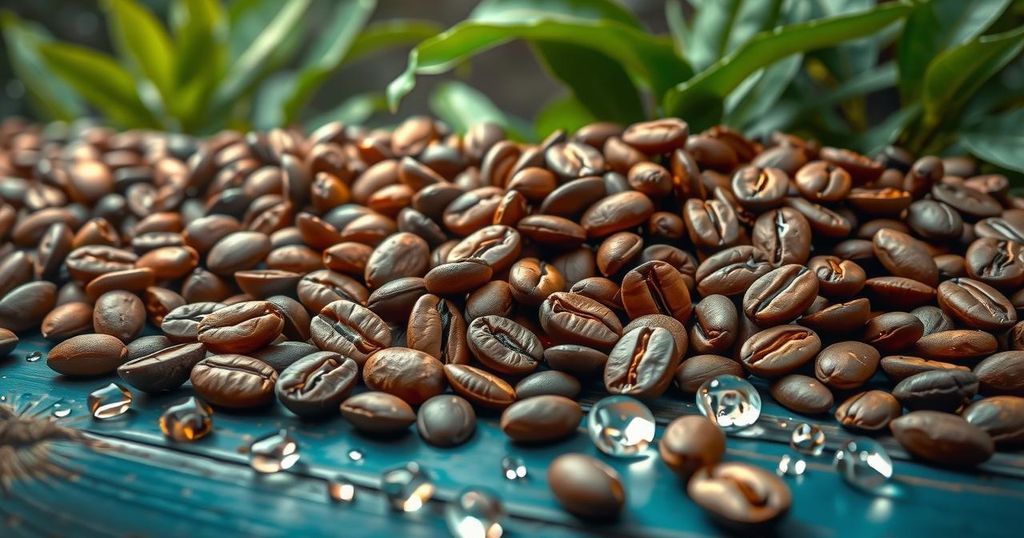Forecasted Rain in Brazil Results in Significant Liquidation of Coffee Futures
Predicted rain in Brazil has led to a sharp decline in coffee futures, with arabica prices dropping by 5.49% and robusta by 3.44%. Supply concerns persist due to high sales percentages and reduced inventories, while adverse weather conditions may affect future crops. Overall, there is a cautious market outlook concerning coffee prices.
The latest reports indicate that forecasts of rain in Brazil have catalyzed a significant decline in coffee futures, evidenced by a drop of 5.49% in May arabica coffee prices and a 3.44% decrease in May ICE robusta coffee prices. According to Somar Meteorologia, hot and dry weather in Brazil is set to transition to several days of rain next week, thus alleviating current drought conditions.
Pressure on coffee prices was further exacerbated by a report from Vietnam’s General Statistics Office, revealing a year-on-year increase of 6.6% in coffee exports for February, totaling 169,000 MT. Additionally, forecasts predict daily rain in Vietnam’s Central Highlands, contributing to the downward trend in coffee prices.
Recent data from Somar Meteorologia shows that Minas Gerais, Brazil’s primary arabica coffee region, received only 24% of the historical average rainfall during the week ending February 22. Rainfall reports were delayed due to the Brazilian Carnival holiday. As the leading producer of arabica coffee globally, Brazil’s weather patterns dramatically influence coffee prices.
Another positive factor for coffee prices includes shrinking inventories, with ICE-monitored robusta coffee stocks falling to a two-month low of 4,247 lots. Conversely, arabica coffee inventories have decreased to a nine and a quarter month low but rebounded to a two-week high of 809,128 bags as of last Thursday.
Producers in Brazil have sold a higher percentage of the upcoming harvest compared to previous seasons. As of February 11, Safras & Mercado reported that 88% of Brazil’s 2024/25 coffee harvest had been sold, exceeding last year’s figure of 79% and surpassing the five-year average of 82%. Sales for the 2025/26 crop, however, remain slow at 13%, indicating uncertainties about new supply.
Supply fears continue to support coffee prices, with Cecafe reporting a 1.6% year-on-year decline in Brazil’s January green coffee exports. Additionally, Conab forecasts a 4.4% decrease in Brazil’s coffee crop for 2025/26, marking a three-year low. It has also reduced its estimate for the 2024 crop.
The long-term damage from last year’s El Niño-induced drought may threaten future coffee yields in South and Central America. Brazil, facing its driest conditions since 1981, has seen below-average rainfall since April last year, harming crucial coffee flowering stages and impacting prospects for the 2025/26 harvest.
Robusta coffee prices are supported by decreased production due to drought in Vietnam, resulting in a 20% drop to 1.472 million MT for the 2023/24 crop year. Projections suggest a slight dip in robusta production for the 2024/25 marketing year.
Nonetheless, broader global coffee exports present a bearish outlook for prices, with increased exports from Brazil offset by declines in global coffee exports in December. The USDA’s biannual report suggests a 4% rise in world coffee production for the 2024/25 year.
Recent estimates also indicate a widening arabica coffee deficit for the 2025/26 marketing year. Volcafe has revised its Brazil arabica production estimate downward after observing the drought severity during crop assessments. The report projects a global arabica coffee deficit, continuing a trend of deficits for several consecutive years.
In summary, forecasts for rain in Brazil have instigated a notable decline in coffee futures, with significant pressure arising from market reports and export statistics. The data suggest a complex interaction between increasing harvest sales, shrinking inventories, and ongoing supply concerns, particularly due to adverse weather patterns affecting key coffee-producing regions. Furthermore, broader global export trends and production forecasts signal a cautious outlook for coffee prices moving forward.
Original Source: www.tradingview.com




Post Comment